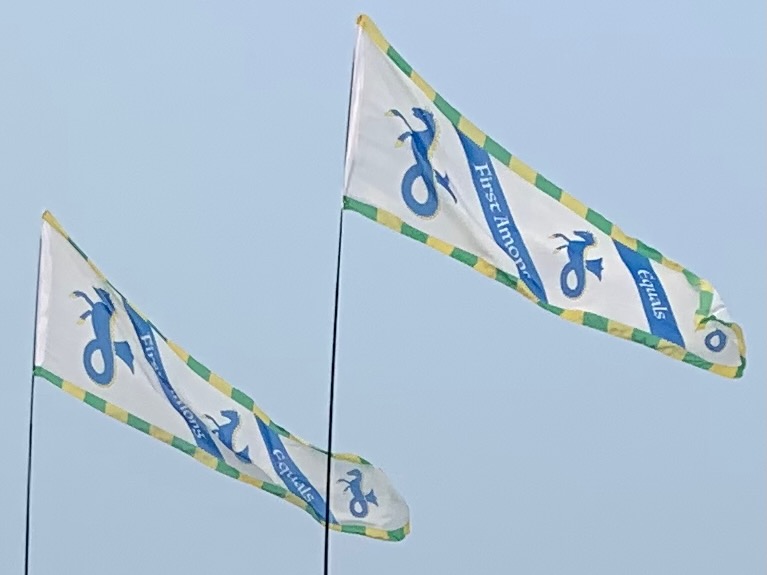Colorful pennants and long standards fluttering in the breeze significantly enhance the ambiance of outdoor historical recreation events — but hand-painting silk can be a daunting project, and requires skills that I have not mastered.
To approximate the impression while leveraging my collection of digital images, I turned to a custom fabric printing service from Spoonflower. The results were satisfactory, so I’ve written up the process I used in case others would like to follow it.
Spoonflower and their competitors use giant inkjet printers to transfer any 150 DPI image you choose onto a wide variety of fabrics. For this project I selected their very light-weight chiffon (just 1.5oz per square yard), which comes in a 54″ width at a cost of $24 per printed yard.
The chiffon is translucent, and sufficiently transparent that the print is visible on both sides. However the colors are not as saturated as they would be on heavier-weight fabrics from the same service; you’ll want to use bold tints in your digital art, and choose a darker shade than you might use elsewhere.
Because only a single layer of fabric is required, the flags are remarkably light and provide a lovely fluttery effect in even a minimal breeze. And their minimal weight means that you can support them on a much lighter pole than you would need for a heavier flag.
I used my preferred digital illustration application to lay out a design of three yards by the full width of the fabric, and filled it with two six-foot standards, two four-foot standards, and sixteen two-foot pennons.

The standards feature the populace badge of Østgarðr and the words “First Among Equals,” alluding to the Crown Province’s precedence as the founding branch of the East. The pennons feature the populace badges of the province and its four cantons (twice each) as well as six local awards.
The fabric, printing, and expedited shipping cost just under $100.
The fabric was cut and machine-hemmed (by someone who knows how to do such things); rolled hems reportedly required some effort and a careful selection of presser foot, but we also got acceptable results out of simply running a dense line of zig-zag stitching along the edges. (We didn’t try just running a bead of fray-check along the edge but that might also do the job.)
The four-foot standards were attached to six-foot bamboo rods and mounted on the top of our communal pavilion, while the six-foot standards were attached to ten-foot telescoping fiberglass rods ($20 at Amazon) and mounted on top of our eight-foot tall camp gate.
It’s not a hand-painted silk banner, but from twenty or a hundred feet away, it does capture some of that feeling.




